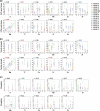Materials informatics approach to understand aluminum alloys
- PMID: 32939178
- PMCID: PMC7476514
- DOI: 10.1080/14686996.2020.1791676
Materials informatics approach to understand aluminum alloys
Abstract
The relations between the mechanical properties, heat treatment, and compositions of elements in aluminum alloys are extracted by a materials informatics technique. In our strategy, a machine learning model is first trained by a prepared database to predict the properties of materials. The dependence of the predicted properties on explanatory variables, that is, the type of heat treatment and element composition, is searched using a Markov chain Monte Carlo method. From the dependencies, a factor to obtain the desired properties is investigated. Using targets of 5000, 6000, and 7000 series aluminum alloys, we extracted relations that are difficult to find via simple correlation analysis. Our method is also used to design an experimental plan to optimize the materials properties while promoting the understanding of target materials.
Keywords: 106 Metallic materials; 404 Materials informatics / Genomics; Markov chain Monte Carlo; Materials informatics; aluminum alloys.
© 2020 The Author(s). Published by National Institute for Materials Science in partnership with Taylor & Francis Group.
Conflict of interest statement
No potential conflict of interest was reported by the authors.
Figures







References
-
- Meredig B, Agrawal A, Kirklin S, et al. Combinatorial screening for new materials in unconstrained composition space with machine learning. Phys. Rev. B. 2014;89:094104.
-
- Seko A, Togo A, Hayashi H, et al. Prediction of low-thermal-conductivity compounds with first-principles anharmonic lattice-dynamics calculations and Bayesian optimization. Phys. Rev. Lett. 2015;115:205901. - PubMed
-
- Ju S, Shiga T, Feng L, et al. Designing nanostructures for phonon transport via Bayesian optimization. Phys. Rev. X. 2017;7:021024.
LinkOut - more resources
Full Text Sources
Other Literature Sources
